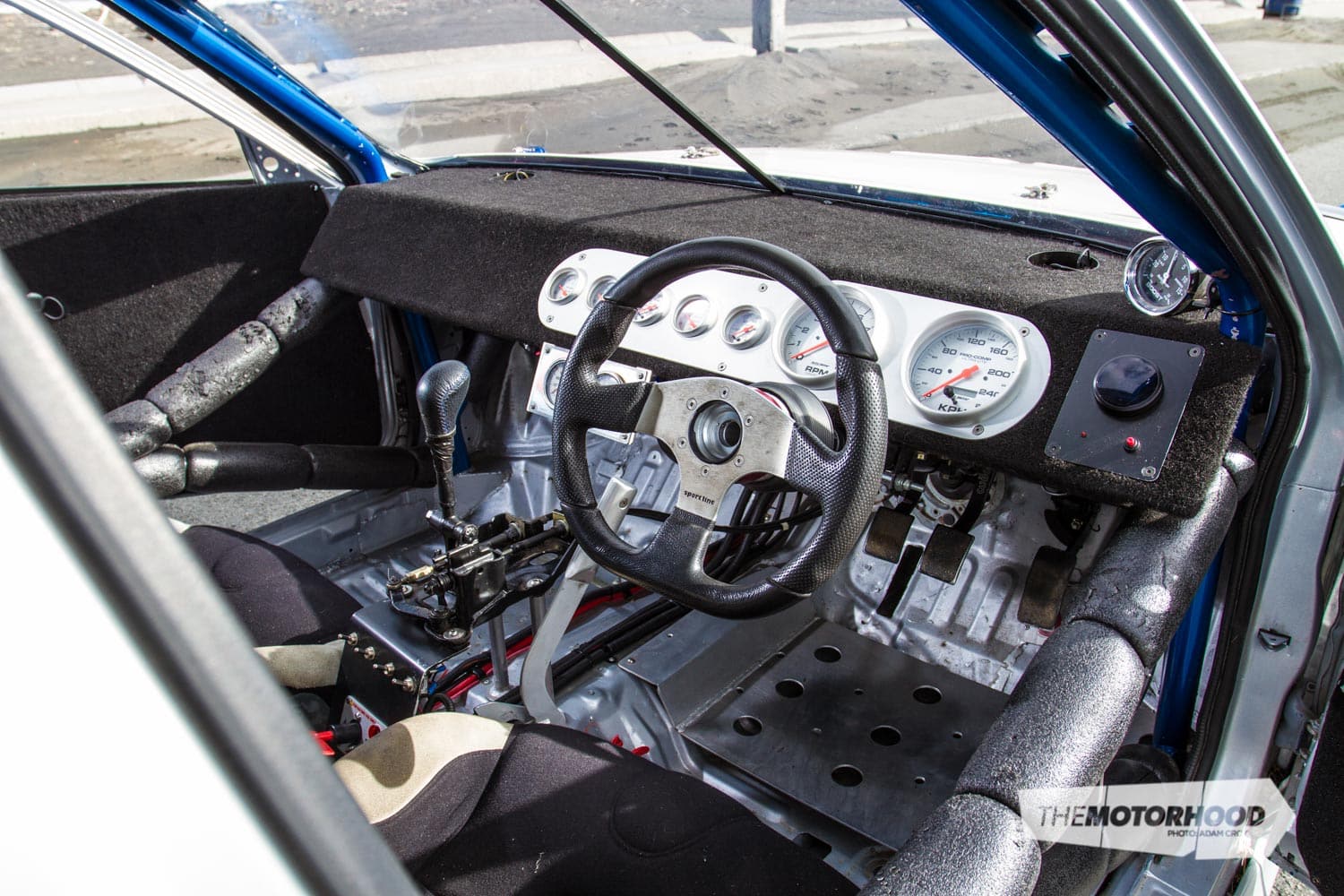data-animation-override>
“Damian Johnson has transformed this Mitsubishi heavyweight from a parts shell into a nimble hill-climb warrior”

If you had seen this Mitsubishi before the build, you would’ve been dead certain it was destined for the scrapyard. But sometimes it’s the most unexpected vehicles that get the most extravagant transformations, and Damian Johnson — a fabricator by trade — has certainly achieved that with his VR-4. Covered in rust, sitting on steelies, with no panels, doors, or interior, it was a sight for sore eyes, and a vehicle Damian only purchased so he could use the gearbox in his daily. But things took a turn when he became involved with his local Wanganui car-club hill climbs, as he explained. “I walked outside one day during the Christmas holidays after being involved with the car club, and decided to drag the shell out of the garden and do something with it. My original idea was to use the running gear out of my daily VR-4, so that’s what I did. It all started there.”

Engine builds have the potential to snowball at times, and although Damian’s did to an extent, he had a clear plan from the beginning, after he’d got started on the engine. “When we pulled down the stock motor for a rebuild, the ring lands broke away from the pistons. So at the time I thought I may as well do forged pistons, and while I’m at it, rods, and head bolts. As you do,” he explained. After forging the generation-one 4G63, there was no real point in running the stock turbo set-up as it would be the limiting factor, given the engine is capable of so much more. Lucky for Damian, a company up in Hamilton was parting out one of its track cars, and he scored the Garrett GT3582R (.63) turbo set-up for a steal, which after inspection was determined to have travelled no more than 50 kilometres. “After the turbo set-up was installed, the rest of the plumbing was fabricated by me, the 264-degree camshafts were bolted in, and I had a Link G4 Storm ECU installed. Soon after, my mate got it running so I could run in the cams before the initial tune,” Damian told us.

After that initial dyno tune by Keith Stewart, it produced 220kW (295hp) at the wheels on low boost, and was now ready for the engine to be run in. Several Manfeild track days later, the VR-4 was trailered down for the final tune, and Damian told us, “Keith stopped at 270kW at the wheels, which is plenty of power for hill-climb racing. I wanted heaps of low-down torque, which it now has.”
With the engine well and truly sorted, it was time for Damian to figure out how to get this power down and make use of the all-wheel drive, but he knew the VR-4 was too heavy to be competitive. He began by cutting the front-end sheet metal off and building the tube framing and roll cage, deleting the unnecessary four-wheel-steering components, bushes and mounts, and grafting in and solid-mounting Mitsubishi Lancer components, which are far lighter. The biggest weight loss came from installing the Lexan windows and screens, and now this once 1400kg-plus heavyweight weighs a measly 1080kg — lighter than the GSRs of the ’90s.

To get the new-found power to the ground, an Evo III gearbox was sourced to replace the long-legged VR-4 unit. “I installed an Evo III gearbox, which has an LSD front diff, Ralliart viscous coupling, and a mechanical rear diff. With the VR-4 gearbox, I found myself constantly on the limiter in second at hill climbs, and if you changed to third gear it was too lazy. With the Evo III unit, it’s much easier to keep it on song.” Toyo R888 semi slicks measuring 235/45R17 were chosen for the optimum balance between mechanical traction and mechanical failure. During previous attempts with a full slick tyre, several gearboxes and countless differentials were destroyed.
A capable all-rounder, Damian’s VR-4 has conquered plenty of hill climbs over the years, but also circuit events such as the North Island Jamboree at which he often hands it to the big boys — one year even winning Superlap outright. Although Damian is a privateer, he doesn’t come unprepared whenever he mixes up his motorsport disciplines. For circuit use, suspension components are dialled in, the ride height is lowered and the front diffuser is installed, which goes right the way under the engine. For hill-climb duties, the VR-4 is raised up and given some more travel, sway bar size is decreased to allow more chassis movement, and the diffuser is removed just in case Damian drops a wheel and scrapes the undercarriage.

As diverse as Damian’s circuit and hill-climb tactics are, there is one constant that has seen him excel over others — his attitude, as he explained: “When I got to a race meeting, I don’t look at the times until the end of the weekend. Most people get too caught up chasing that extra second, but I do the opposite — I drive to my conditions and to what I can do. To this day, I still just go out there and do my own thing, and see how well I did at the end of the day. Consistency gets me through.”
1988 Mitsubishi Galant VR-4 (E38A)
Engine
- Model: 4G63, 2000cc four-cylinder
- Block: Wiseco forged pistons, forged rods, ACL race bearings, ARP head studs, balance shaft removed, metal head gasket
- Head: Flowed head, 264-degree cams, adjustable cam gears
- Intake: Pod filter, four-inch intake pipe, 2.5-inch intercooler piping, Heat Exchange Services intercooler
- Turbo: Garrett GT3582R (.63)
- Wastegate: 50mm Turbonetics
- BOV: GReddy
- Fuel: Jaz fuel cell, Carter lift pump, two-litre surge tank, SX 1200hp fuel pump, two SX fuel filters, SX fuel-pressure regulator, SARD 800cc injectors
- Ignition: Factory coils, iridium spark plugs, 10mm spark-plug leads
- Exhaust: Custom turbo manifold, custom three-inch turbo-back exhaust system, Flo~Pro muffler
- Cooling: Aluminium radiator, 12-row oil cooler
- ECU: Link G4 Storm
- Other: Custom oil catch can, tube-framed front end
Driveline
- Gearbox: Evo III, five-speed
- Clutch: Solid centre five-puck
- Flywheel: Lightened
- Diff: Evo mechanical LSD
- Other: Evo subframe, custom Evo driveshaft
Support
- Struts: BC BR Series adjustable coilovers
- Brakes: (F) 350mm Wilwood two-piece slotted rotors, six-pot Wilwood calipers, (R) slotted factory rear rotors, factory VR-4 front calipers, custom hydraulic handbrake
- Other: Wilwood pedal box, Wilwood master cylinder, brake-bias gauges
Interior
- Seats: Racetech 4000W, Racetech five-point harnesses
- Steering wheel: Sportline
- Instrumentation: Auto Meter Pro-Comp gauges, Accutech brake-pressure gauges
- Other: Custom dashboard, removed steel and sound deadening
Exterior
- Paint: Toyota silver
- Enhancements: Lexan MR10 windows, Evo V front bumper, bolt-on flares
Performance
- Power: 270kW at the wheels on 22psi of boost with pump gas
- Circuit times: Manfeild — 1.15
This article was originally featured in a previous issue of NZ Performance Car. Pick up a copy of the edition below:














